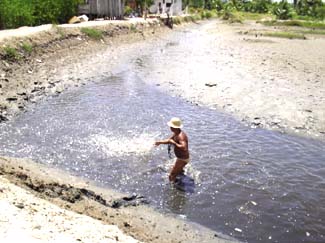Panama City, Panama, 4–6 September 2005
Doris Soto1 and José Aguilar-Manjarrez2
FAO-FIRI commissioned the Organization of the Fisheries and Aquaculture Sector in Central America (OSPESCA) to collect, review and synthesize the National Aquaculture Sector Overviews (NASO) and Prospective Analyses of Future Aquaculture Development (PAFAD) from the Latin America and the Caribbean (LAC) countries. The purpose of NASO and PAFAD is to provide a concise and comprehensive product that gives a general overview of the aquaculture and culture based fisheries aspects and development outlooks at national level for each country. OSPESCA was also to compile, on their basis, a Draft Regional Review and Synthesis of Aquaculture Development Trends in the LAC Region. To review this draft, FAO-FIRI/OSPESCA jointly organized the FAO Expert Workshop on the Regional Aquaculture Review for Latin America and the Caribbean.
The workshop was hosted by the Government of Panama and was held in the Las Americas Meeting Room of the Hotel Country Inn & Suites, Panama Canal Amador of Panama, Republic of Panama from 4 to 6 September 2005. Twenty three experts from 21 countries of LAC attended the meeting.
The main objectives of the Expert Meeting were to present, discuss and synthesize: (i) the NASO and PAFAD from the countries in the LAC, and (ii) the Draft Regional Review and Synthesis of Aquaculture Development Trends in LAC.
The meeting carried out a comparative analysis of the performance of aquaculture in LAC, grouping the countries by geography and similarities in their aquaculture systems. This grouping of countries was meant to facilitate the regional synthesis, which was the central purpose of the meeting. For the comparative analyses, information provided by national experts from 22 countries in the Region was used. For each group of countries, information was given on land area; human population; Gross Domestic Product; institutions of aquaculture training and research and development; cultured area and cultured aquatic species; and aquaculture production, in volume and value. Indicators of aquaculture productivity or yield, opportunities and trends of the sector, and main problems affecting aquaculture development were also examined. The regional synthesis considered a series of issues selected, such as institutional framework, legislation, environment, marketing and contribution of aquaculture to social and economic development, and the most important trends observed for each issue. Finally, the meeting conducted a SWOT (strengths, weakness, opportunities and threats) analysis of aquaculture development at regional level.
Some of the relevant common issues identified by the experts included: (i) lack of estimation of economic and social impacts of aquaculture as well as the scarcity of information about the impact on local protein consumption; and (ii) weak coordination and management of environmental issues particularly regarding institutional coordination (usually among fisheries and environmental institutions); (iii) need for strengthening of government and institutional frameworks; (iv) the need for enhancing of sub-regional and regional cooperation; and (v) the need to control the spread of diseases, and particularly regarding movements of exotic species.
The workshop report will be published in Spanish and English and made available to governments, and will be part of the Global Aquaculture Review. FAO is currently working on a database of National Aquaculture Sector and Legislation Overviews, to be made available on FAO's aquaculture gateway http://www.fao.org/figis/servlet/static?dom=root&xml=aquaculture/index.xml
For more information please contact:
Doris Soto at FIRI
e-mail: [email protected]
José Aguilar-Manjarrez at FIRI
e-mail:[email protected]

Doris Soto, FAO
Harvesting of shrimp in a family type aquaculture pond by a river estuary near the city of Recife, Northern Brazil

Doris Soto, FAO
Family type shrimp farms in a river estuary near the city of Recife, Northern Brazil

Doris Soto, FAO
Family aquaculture ponds which produce Tilapia and Tambaqui within cane farming area in Pernambuco State, Brazil
1 Doris Soto
Inland Water Resources and Aquaculture Service
FAO Fisheries Department, Rome